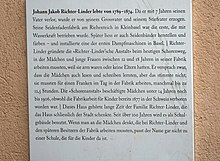Johann Jakob Richter
Johann Jakob Richter (born April 24, 1789 in Böckten ; † August 5, 1874 in Basel ) was a Swiss businessman and entrepreneur .
life and work
Johann Jakob Richter was the son of the wool weaver and publisher Johann Rudolf Richter and Anna Maria, née Wirz. When his father died, his grandfather took over the upbringing of the seven-year-old.
After Richter had completed his training as a businessman in Aarau , he returned to Basel and worked in a silk ribbon shop . In 1812 he married Anna Maria, née Linder, who was a daughter of the silk ribbon manufacturer Johann Jakob Linder. After the death of his father-in-law in 1813, Richter became a partner in his business. In 1814, as an independent entrepreneur, he also took over the factory in Arlesheim , which he operated until 1830. In 1820, Richter also founded a silk fabric business and a flax spinning mill in Dornach .
In 1831 Richter exchanged the factory in Arlesheim for landscape companies and a silk winding and twisting mill on Hammerstrasse in Kleinbasel . Here he operated at times up to 124 silk ribbon looms. In addition, the operation also included the “Richter-Linder'sche Anstalt”, which was opened in Kleinbasel in 1853. This was built for the poor Baselbieter children who worked in the factories. Richter promised that the children would also learn to read and write in the institution, but that was not true.
From 1859 to 1870 the St. Urban monastery in Pfaffnau was also part of the family business. Here Richter tried to set up a sericulture . Due to the unsuitable climatic conditions, however, the desired success was not achieved. In 1840, Richter was one of the first steam engines to be integrated into his business and founded his own silk ribbon dyeing factory. At St. Jakob on the Birs , he also took over another factory on lease. Although factory work for children was banned in Switzerland as early as 1877, the "Schorenanstalt" in Arlesheim let children work in its factories until 1906. In the 1870s, Richter had to file for bankruptcy.
Richter was one of the founders of the Basellandschaftliche Hypothekenbank and held numerous municipal and cantonal offices.
literature
- Emil Thürkauf: Publishing and home work in the Basel silk industry, Basler Volkswirtschafte Arbeit, Kohlhammer Verlag Stuttgart, 1909.
Web links
- Barbara Alder: Johann Jakob Richter. In: Historical Lexicon of Switzerland .
- Isabel Koellreuter : Johann Jakob Richter. In: Personal Lexicon of the Canton of Basel-Landschaft
- Johann Jakob Richter-Linder. In: Online archive catalog of the Basel-Stadt State Archives
| personal data | |
|---|---|
| SURNAME | Judge, Johann Jakob |
| BRIEF DESCRIPTION | Swiss businessman and entrepreneur |
| DATE OF BIRTH | April 24, 1789 |
| PLACE OF BIRTH | Böckten |
| DATE OF DEATH | August 5, 1874 |
| Place of death | Basel |
